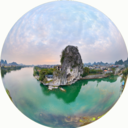0 Likes
陆家嘴金融贸易区是中国上海的主要金融中心区之一,位于浦东新区的黄浦江畔,面对外滩。整个金融贸易区总面积共有28平方公里,其中规划开发地区为6.8平方公里,已有约100座大厦落成。1990年,中国国务院宣布开发浦东,并在陆家嘴成立全中国首个国家级金融开发区。经营人民币业务的外资金融机构,必须在陆家嘴金融贸易区开设办事处,因此陆家嘴是不少外资银行的总部所在地。目前共有多家外资金融机构在陆家嘴设立办事处,当中经营人民币业务的包括汇丰银行、花旗银行、渣打银行、东亚银行等。





Overview and HistoryIn contrast to the long and deep history of most Chinese cities, the story of Shanghai is rather short and to the point. It began as a fishing village, got rich, and suddenly became the biggest city in China.Let's see what's at the bottom of it all. Archaeological digs around Shanghai show artifacts dating to the Neolithic Period six thousand years ago, giving evidence of hunters, fishermen and early farmers. During the period of warring states in ancient China, Shanghai was nothing more than a little fishing village. Around the year 200 AD, in the Han Dynasty, Shanghai developed industries of salt production, casting coins and other metallurgic processes.Over the next five centuries Shanghai grew and became a major food producer for southern China, gathering population and increasing its trading. After the nearby Wusong river filled with silt, Shanghai found a niche as a shipping port and attracted a much wider range of traffickers.The town of Shanghai was officially established in 1267 AD amidst a swarm of merchant ships doing business. It became one of only seven maritime shipping headquarters in the whole of China.Industrial development of cotton and textiles combined with the transportation capacity of the port to make Shanghai into the largest cotton producer in the country. International trade began along with the carriage trade along the Yangtze River.A Customs Office was established in 1685 to collect import taxes in response to the growing arrival of foreign ships. By the nineteenth century Shanghai was a paradise of international trade in textiles, porcelain and industrial raw materials with a large service economy of banking, printing, architecture and pharmaceuticals.This set the stage for the Opium Wars of the nineteenth Century. The British were doing a booming business taking opium from India and selling it in China, to offset their transportation costs of whatever they wanted to bring back from the "far east." They were annoyed at both the high Chinese import taxes and the prohibition of opium import in the middle of this "Adventurer's Paradise".Understandably, the Chinese didn't like drug-dealing foreigners turning all their people into addicts! Opium was first used in its medical capacity for stopping diarrhea, but the pharmacists of the day prescribed it everywhere in the world as a cure-all for almost any symptom. By the seventeenth century, thousands of Chinese opium addicts along with a serious smuggling trade had arrived in China's cities. This was the fundamental conflict that led to the Opium Wars of the 1840's and 50's.Bang! The British had the naval power, China had the ports and desirable location. In the end, a series of treaties left Britain with Hong Kong and China with limitations on how they could rule even their own territory! Other ports and borders were soon opened to international trade and the precedent for the next one hundred years was set. This period is referred to by the Chinese as the time of unequal treaties; their amazing economic growth in recent years is a testament to their long memory of it.The twentieth century found Shanghai still growing with modern industry and improved production techniques in its factories. The Republic of China was founded in 1912 and in 1927 Shanghai was proclaimed to be a special municipality. It had a Chinese Section, the International Settlement and the French Concession.Japanese airplanes bombed Shanghai in 1932 and occupied the city as of 1937. They stayed until 1945 when, at the close of WWII, the Communist Party of China regained control of Shanghai. When the Communist party took over in 1949 and closed the borders to foreign investment, the economic development of Shanghai slowed dramatically. Most foreign investors withdrew and moved their offices to Hong Kong. The People's Republic of China ended Shanghai's status as the most cosmopolitan city in China.Getting ThereFly into Shanghai at one of its two airports, Pudong or Hongqiao. The Pudong airport is connected to the city via the world's first maglev train -- that's a magnetic levitation system where the train doesn't have wheels. It covers the 30km distance in a matter of seven minutes, whooooosh!TransportationPublic transportation within Shanghai is extensive and well-developed. There are buses, trolleys, taxis and a growing metro system. Their version of a monthly pass is the Shanghai Public Transportation Card. It uses radio frequencies to communicate with the scanner without any physical contact! There's a little microchip in the card that does it as you walk through the entrance. It's an interesting technology which is adaptable to being implanted within humans, too.The bus system is the most extensive in the world with almost one thousand different lines. Use of the public transport is encouraged by a limited number of vehicle license plates and also gradual restrictions on bicycle riding.People and CultureShanghai's rapid growth has filled it with ambitious people at a high population density. It can feel crowded and competitive just as any other large city like New York or London. Shanghai's art and culture has the reputation of lagging behind its financial growth, however, artists are working to create world-class contributions to represent their city.Things to do, RecommendationsThe Bund is on top of the list of must-see Shanghai spots. It's got a great collection of 20th Century buildings from the time when Shanghai was the financial center of foreign investment.Stop in at the Shanghai Science and Technology Museum for a look at some of the more recent progress after the Bund.The Shanghai East arts center is an important symbolic and cultural center which, when seen from above, blooms out from its center like a flower with five petals. It's got the most advanced technical setup of any theater facility in the country and perhaps, the world.It's not all high-tech, don't worry. Shanghai has some beautiful gardens like this one, the Yuyuan Garden, where you can rest your eyes and refresh your spirits among the balance of nature.Here you go, the moment you've all been waiting for! It's the Oriental Pearl Broadcasting & TV Tower, second tallest in Asia and fourth tallest in the entire world, behind only the Eiffel Tower in annual visitor numbers! This is the place above all else from which to view Shanghai. Enjoy!Text by Steve Smith.